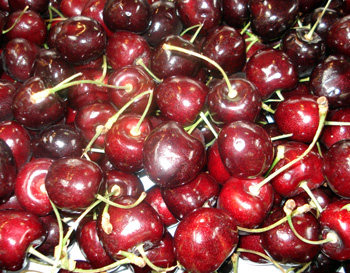 Sweet Cherries
Sweet Cherries© Paula Trites
Sweet Cherry trees grow up to 36 feet (11 metres) tall, which is much taller than Sour Cherry trees. They also spread out almost as wide as they are tall.
Unlike Sour Cherry trees, a Sweet Cherry tree can’t pollinate itself; it needs another Sweet Cherry tree to cross-pollinate with. And not just any Sweet Cherry tree. Sweet Cherry trees of the same type will not cross-pollinate, and even amongst the varieties there are some that won’t cross-pollinate with each other. For instance, Bing, Emperor Francis, Lambert, Napoleon, and Star Cherry trees can’t cross pollinate with each other. Consequently, when planting Sweet Cherry trees, growers have to not only plant different varieties, but also chose varieties that will pollinate each other — and make sure that these varieties bloom at the same time. In addition to all this, bees are needed to do the pollination, so growers often put bee hives in their orchards.
The complicated planning required for pollination, plus the number of trees required, plus the huge size of each tree, is what makes them very uncommon in home gardens.
Sweet Cherries are larger than Sour Cherries. They are heart-shaped and firm. The skin can be yellowish, or dark red to dark reddish-purple. Popular North American varieties include Royal Ann, Bing, Lambert and Tartarian.
The trees have to be netted, or have bird scaring devices on them, because birds love these trees.
Sweet Cherry cultivars are divided into two groups. Mazzards are heart-shaped, softer fruits (Guigne in French, Gean in the UK.) The Bigaroon group (“Bigarreau” in France and the UK) are round, firm, crisp fruits.
Cooking Tips
Sweet Cherries can be eaten out of hand as a fresh dessert fruit, or be used in cooking.
History Notes
The first attempt to introduce Sweet Cherries into North America didn’t work out. They were brought over with British colonists in 1629 and planted on the East Coast, but they died out. Sour Cherry trees were more hardy and were grown there instead. Sweet Cherries were reintroduced over on the West Coast by Spanish missionaries.
Language Notes
The Latin name “Prunus avium” can be broken down as follows in a way that any gardener will understand. “Prunus” meant cherry or plum (the Greeks and Romans kind of used the same word for both), and “avium” comes from “avis”, meaning birds. So, a fruit that you grow and that the birds eat.
Sweet Cherries are also called “Dessert Cherries”, meaning that they can be eaten fresh out of hand. But given that Sour Cherries can be cooked up in a baked good for dessert, this terminology can be unhelpful.

